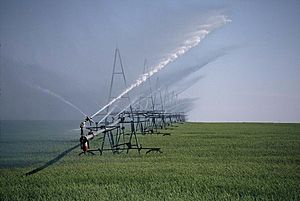Green Revolution facts for kids
The Green Revolution was a big change in farming that happened in the 20th century. It helped countries around the world grow much more food. This was possible because scientists found new ways to make crops produce more.
Before this time, many countries struggled to grow enough food for their people. But thanks to new ideas and tools, farms started producing huge amounts of rice, wheat, and other important crops. This helped feed millions of people and changed how we farm forever.
Contents
What Was the Green Revolution?
The term "Green Revolution" describes a time when farming changed a lot, starting in the 1960s. It was a period of rapid growth in agriculture. This growth was driven by new scientific discoveries and technologies. The main goal was to increase food production, especially in developing countries.
How Did It Start?
In the 20th century, rich countries spent a lot of money on science to improve farming. Organizations like the Rockefeller Foundation and Ford Foundation helped share these new ideas. They wanted to help developing countries grow more food. Their first efforts focused on rice and wheat, which are key foods for many people.
Key Changes in Farming
The Green Revolution brought several important changes to how farmers grew crops. These changes worked together to create much higher yields.
Better Seeds
One of the biggest breakthroughs was creating new types of plant seeds. Scientists developed "high-yield" varieties of wheat and rice. These new plants could produce much more grain than older types. They were also stronger and more resistant to diseases.
Using Fertilizers and Pesticides
To make these new seeds grow even better, farmers started using more fertilizers. Fertilizers are special nutrients that help plants grow big and strong. Farmers also used pesticides. Pesticides are chemicals that protect crops from harmful insects and weeds. This stopped pests from eating the food before it could be harvested.
More Water for Crops
Another key part of the Green Revolution was better irrigation. Irrigation means supplying water to farmland, often through canals or pipes. With more reliable water, crops could grow steadily. This was especially important in places where rainfall was not always enough.
Where Did It Happen?
The Green Revolution had a huge impact, especially in Asia and Latin America. Countries like India, Mexico, and the Philippines saw their food production soar. This helped many people avoid hunger and improved their lives. It showed how science could solve big problems.
Why Was It Important?
The Green Revolution helped feed a growing world population. It prevented famines in many areas. It also changed farming into a more modern and scientific process. While it brought many benefits, it also led to discussions about using chemicals and water. Scientists continue to work on making farming even better and more sustainable.
Images for kids
-
After World War II, newly implemented agricultural technologies, including pesticides and fertilizers as well as new breeds of high yield crops, greatly increased food production in certain regions of the Global South.
See also
 In Spanish: Revolución verde para niños
In Spanish: Revolución verde para niños





